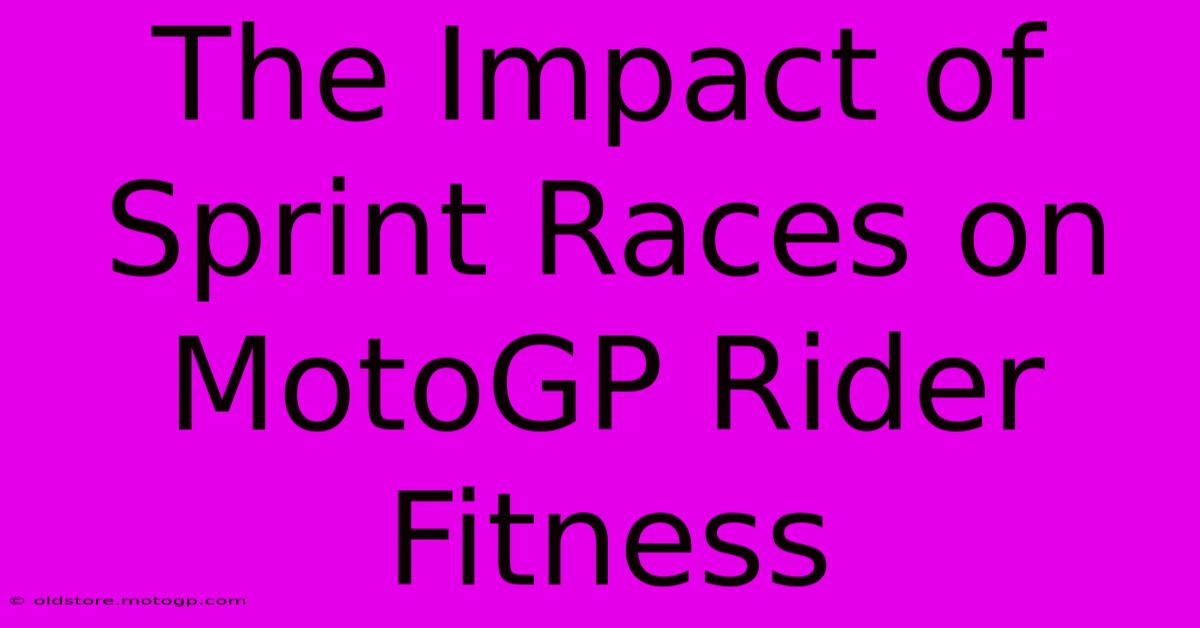The Impact Of Sprint Races On MotoGP Rider Fitness

Table of Contents
The Impact of Sprint Races on MotoGP Rider Fitness
The introduction of sprint races to the MotoGP calendar in 2023 has significantly altered the demands placed on riders, pushing the boundaries of physical and mental endurance. While adding excitement for fans, these shorter, intense races present a unique challenge, impacting rider fitness in several key ways. This article will explore the multifaceted effects of sprint races on MotoGP rider preparation, performance, and overall well-being.
Increased Physical Demands: A Double Header Challenge
The most immediate impact of sprint races is the increased physical workload. Riders now face two races per weekend, effectively doubling the physical exertion compared to the traditional format. A sprint race, while shorter, is still incredibly demanding, requiring maximum effort for a sustained period. This translates to:
- Higher heart rates and lactate levels: Maintaining peak performance over consecutive races leads to prolonged periods of high physiological stress.
- Muscle fatigue and micro-tears: The repetitive high-intensity contractions involved in riding a MotoGP bike exacerbate muscle fatigue and increase the risk of micro-tears, potentially leading to injuries if not properly managed.
- Dehydration and electrolyte imbalance: The intense physical exertion combined with the heat generated by the bikes and ambient conditions can lead to significant fluid and electrolyte loss.
Strategies for Managing Increased Physical Strain
To counter these intensified physical demands, riders are adapting their training regimes. This includes:
- Enhanced cardiovascular training: Increased focus on endurance and recovery protocols to withstand the double workload.
- Strength and conditioning programs: Emphasis on building and maintaining muscle strength and power to manage fatigue and reduce injury risk.
- Nutrition and hydration strategies: Precisely calibrated nutrition plans to optimize energy levels and replenish lost electrolytes.
- Recovery techniques: Utilizing advanced recovery methods such as cryotherapy, massage, and sleep optimization to facilitate faster recovery between races.
Mental Fortitude: The Psychological Toll
Beyond the physical strain, sprint races also pose a significant mental challenge. The pressure to perform at the highest level twice in a single weekend is immense, demanding exceptional mental resilience and adaptability. This includes:
- Increased cognitive load: Riders must manage a higher volume of information and decision-making processes in a shorter time frame.
- Stress management: Effective stress management strategies are crucial to prevent burnout and maintain optimal performance.
- Race strategy adjustments: Riders need to adapt their race strategies to account for the shorter sprint race format and potential impacts on tire wear and fuel consumption.
Adapting Mental Training for the New Format
Riders are increasingly incorporating mental training techniques to enhance their psychological preparedness:
- Mindfulness and meditation: These techniques help in managing stress, improving focus, and enhancing mental clarity.
- Visualization and mental rehearsal: Mental preparation is crucial to optimize performance and build confidence.
- Performance psychology coaching: Working with sports psychologists to develop individualized strategies for mental toughness and resilience.
Long-Term Effects and Potential Concerns
The long-term impact of sprint races on rider fitness remains to be fully understood. While the immediate effects are evident, the cumulative effect of increased workload over an entire season could potentially lead to:
- Increased risk of injury: The higher frequency of high-intensity exertion elevates the risk of muscular injuries, fatigue fractures and other physical issues.
- Burnout: The demanding schedule and continuous pressure could contribute to rider burnout.
- Compromised long-term health: The cumulative effects of repetitive micro-trauma and high physiological stress could have long-term implications on rider health.
Conclusion: A Necessary Adaptation
The introduction of sprint races has undoubtedly transformed the landscape of MotoGP, demanding significant adaptations from riders. While presenting challenges, it also pushes the boundaries of athletic performance and necessitates a holistic approach to rider fitness that encompasses physical conditioning, mental training, and recovery strategies. Ongoing research and adaptation will be key to understanding and mitigating the long-term effects of this evolving racing format. The future of MotoGP rider fitness will rely on effective management of these new demands.

Thank you for visiting our website wich cover about The Impact Of Sprint Races On MotoGP Rider Fitness. We hope the information provided has been useful to you. Feel free to contact us if you have any questions or need further assistance. See you next time and dont miss to bookmark.
Featured Posts
-
Moto Gp Crash How To Watch Safely
Feb 20, 2025
-
Witness History In The Making Sprint Race Austin
Feb 20, 2025
-
The Power And Glory Of Moto Gp In Pictures
Feb 20, 2025
-
Yamaha V4 Moto Gp The Future Of Moto Gp Engineering
Feb 20, 2025
-
F1 Austin Tv Schedule Dont Be Left In The Dust
Feb 20, 2025
